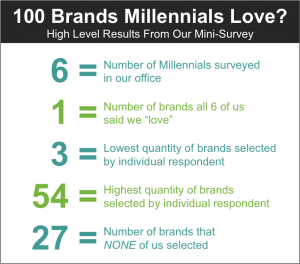Snow Tha Product × göt2be
Latin GRAMMY-nominated rapper and singer Snow Tha Product is partnering with göt2be Color Remix to drive engagement and awareness for the bold...
5 min read
Rosemary Waldrip
:
October 24, 2016

This is the fourth (and final) part of the series, “Marketing to ‘Millennials’? You’re Doing It Wrong.” While not required, we recommend reading Parts One, Two, and Three for maximum value.
As a marketer, it’s pretty much impossible to get through a day without seeing content about “Millennials.”
Be it through articles, ebooks, infographics, or the occasional four-part series, it’s all too easy to get caught up in the incessant buzz about “marketing to ‘Millennials’” without considering the vagueness of this as an objective:
Now don’t get me wrong -- as a marketer, I totally get it. There’s just something alluring about the word “Millennials” that gets me to click on a headline. (True confession: “Millennials” is one of my Google Alert terms).
In fact, there was one particular headline I saw a few weeks ago that led me to write this series in the first place.
I’d been thinking about the issues with “Marketing to ‘Millennials’” for some time but could never seem to cohesively nail down my thoughts. Then a couple of weeks ago, this instant-click headline came through my Google Alerts: 100 Brands Millennials Love
I scanned down the list of brands and kept a tally of which of the 100 I would actually claim to “love.” Much to my dismay, I counted only 12.
I thought, “Hey, maybe my Millennial meter is just off today.” So, I asked a few other Millennials in our company to take the same quick survey.
With a total of 6 responses (Small sample size, I know - but it was what I had to work with) the results were all over the map.
IMPORTANT NOTE: The initial survey the article is based on asked Millennials to list their 3 favorite brands without a prompt, so our mini-survey isn’t exactly a 1:1 comparison. However, it further validated my desire to challenge the assumptions marketers might make based on the article’s headline alone.

It’s also worth noting that all 6 of the Millennials who took our mini-survey vary in age, background, ethnicity, and lifestyle, as well as many other socio- and psycho-graphic characteristics. This ties back to Problem #3, which asked how many people we alienate when marketing to “Millennials.” Even though all 6 of us are “Millennials in Dallas,” we had widely varied responses to a very simple survey.
Which leads to Problem 4...
If I had just read the headline “100 Brands Millennials Love” and briefly scanned the list of brands, I may have made some inaccurate assumptions about the research being presented and the content of the article itself.
In fact, this fourth, final, and most important issue I have with “marketing to ‘Millennials’” relates more to the way we marketers act as content consumers. By that, I mean that we’re BUSY, and it’s very easy to draw conclusions based on quick headlines. The content we read is becoming increasingly more bite-sized...but so, too, is the information we internalize.
Here are a few recent “Millennials”-related headlines from our own newsletter archive:
...all of these are well-written articles, produced by skilled journalists at respected publications. Yet, even here, they blend together if you just read one headline after the other.
Now my hope is not that we all go spend hours of our day pouring over each and every word in these kinds of articles. (Ain’t nobody got time for that.) Instead, we should become more cognizant of the way we digest these headlines. We may be making more assumptions based on headlines than we realize…and, over time, this could ultimately lead to misinformed marketing decisions (in the form of wasted effort, misdirected resources, inaccurate messaging, etc.)
As a quick summary, here are the biggest problems marketers face when “Marketing to ‘Millennials’” is the goal:
Marketing to Millennials is uncomfortably vague. The term “Millennials” means different things to different people, and it’s become a buzzword that perpetuates stereotypes and assumptions, rather than being a true consumer group.
So, while I’m not saying that “Millennials” should be abolished from our segmenting considerations altogether, I am saying that it shouldn’t be our sole focus.
With countless consumer data points now available, marketers leave money on the table when they stop at “Millennials,” especially when glanced-over headlines slowly warp our perceptions of this group.
Headlines don’t always tell the full story. If you’re marketing to “Millennials,” you’re not necessarily doing it wrong, but you could probably be doing it more right.
Are you a Millennial, or know one of the 83 million? We’d love for you to take our “100 Brands Millennials Love” mini-survey (just tally up how many of the 100 brands YOU “love”) and tell us your number in the comments below.

Latin GRAMMY-nominated rapper and singer Snow Tha Product is partnering with göt2be Color Remix to drive engagement and awareness for the bold...

EDM artist ILLENIUM is partnering with the California Department of Public Health to talk about the dangers of Fentanyl, his own substance use...

UScellular® and Chase Rice have partnered to promote the power of unplugging to connect with what matters most.